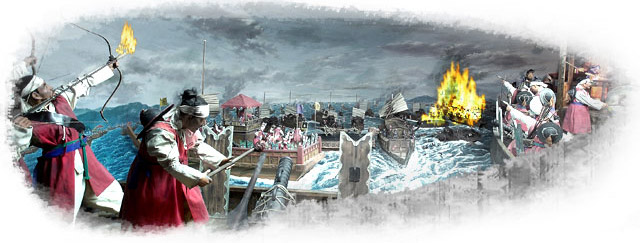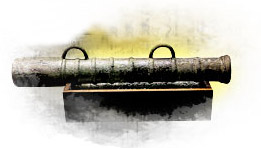Strategy Center
Surprising Ambush
One of the features in the strategies of Yi sun-shin was the surprising ambush. Yi sun-shin would set the goal for attack first, and he undertook all out attack after breaking down the spirit of the enemy by striking the target first.
On Dangpo Battle, he first had the turtle ship to attack the main ship of the enemy and use the Hyeonja Chongtong and various guns to break down the enemy battle ship, and shot the Japanese general Kurujima Michiyuki with the bow to drop him in the sea.
On Danghangpo Battle, the turtle ship was used as spearhead under the bottom part of the commanding ship and shot the Chongtong to break the enemy ship and the enemy commander was hit by the bow and fallen onto the sea. The ship without their general was very easy target and the Joseon naval force was able to totally destroy ships like this.
On Busanpo Battle and Myeongryang Battle, Yi sun-shin remembered the fact that the Japanese force mainly moved around the commander that he penetrated the enemy fleet to destroy the commander ship first with the surprise attack. With these strategies, the turtle ships were very effective as the spearhead ships to penetrate the enemy fleet.
Strategy for Dangpa
Dangpa was a strategy to destroy the enemy ship by impact. During the Imjin War, the panokseon that was the main vessel of the Joseon naval force and the penetrator, turtle ship, had the guns loaded to have the general strategy on breaking down of the enemy battle ships by the shot by the guns.
The dangpa strategy with the turtle ship as the penetrating ship was effectively used in several s2s with Sacheon Battle of May 1592 as the first of its type. In addition to Sacheon Battle, Dangpo Battle, Busanpo Battle and others, the dangpa strategy by the turtle ship and panokseon for each strike impacted heavily to the enemy.
The reason for the Joseon naval force to destroy the enemy ship with the dangpa strategy was that the turtle ship and panokseon were stronger than the enemy ship as well as having much better capabilities of weapons loaded on the battle ship. Yi sun-shin used the dangpa strategy on the basis of the accurate perception on the capability of both sides to gain his victories.

Strategy of Attack with Fire-armsh
Strategy of Using Guns
 Hyeonja chongtong
Hyeonja chongtong
During the Imjin War, the Japanese naval force used its traditional strategy of getting on the ship for person-to-person physical confrontation. This strategy was mainly the strategy to jump on the ship of the enemy and use the personal weapon to kill the enemy, and this was from the strategy of the Japanese invader that looted private ships to take away the personal belongings. Thereafter, with the rifle introduced in the middle of the 16th century, the shooting strategy with the rifle was added to the existing strategy, but the overall strategy had not changed much.
On the other hand, the Joseon naval force facilitated the strategy with guns on the basis of its various large-sized guns loaded on both sides of the ships in addition to the dangpa strategy and fire-arm strategy. In particular, the guns of Joseon forces was much larger shooting distance than the rifles of Japanese forces that the Joseon naval force had the absolute advantage over the Japanese naval force, unlike the battle situation on land.
The Battle of Hansando was triggered by outstanding command and strategy of Yi sun-shin, astonishing spirit and efforts of the Joseon naval force under his command, excellence of the turtle ship and panokseon, and the capability of the large-sized guns. In particular, the Hakik-jin formation was very similar to the formation used in the Battle of Trafalgar by Napoleon of France in later time and the strategy of Admiral Dogo Heihachiro of Japan when he destroyed the Baltic Fleet of Russia in the Korea Strait. A western war historian, G.A. Ballard, had the extreme praise that the strategy utilized by Yi sun-shin was available only for the highly trained fleet with the surprising mobility of the time.
Appropriate Operation of Battle Formation
Looking into the formations that Yi sun-shin facilitated in various battles at the time of the Imjin War, he had maneuvered a variety of formations.
The formation of Yi sun-shin was literally full of changes with unlimited uses of strategies. The commanding capability of Yi sun-shin was changed from time to time depending on situations, and accordingly, he selected the strategy that suits the situation from time-to-time for whatever the situation might present.
The battle ship formations that Yi sun-shin enjoyed were generally Hakik-jin, Jangsajin and Hoengyeoljin. These formations were the facilitation of Eorin Hakik-jin, Paljingibeom and others. When battling, he thought of how to attack the enemy in what location, situation or formation, and appropriately operate it to bring out the best result from the battle.